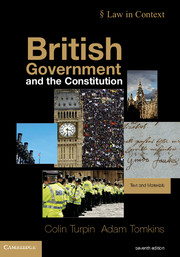Book contents
- Frontmatter
- Contents
- Preface
- Acknowledgements
- Abbreviations
- Table of Cases
- Table of Statutes
- Table of European Treaties
- Part I Constitution, state and beyond
- 1 The British constitutional order
- 2 The ideas of the constitution
- 3 Constitutional sources
- 4 Devolution and the structure of the UK
- 5 The European dimensions
- Part II Government
- Part III Accountability
- Part IV Liberty
- Index
2 - The ideas of the constitution
from Part I - Constitution, state and beyond
- Frontmatter
- Contents
- Preface
- Acknowledgements
- Abbreviations
- Table of Cases
- Table of Statutes
- Table of European Treaties
- Part I Constitution, state and beyond
- 1 The British constitutional order
- 2 The ideas of the constitution
- 3 Constitutional sources
- 4 Devolution and the structure of the UK
- 5 The European dimensions
- Part II Government
- Part III Accountability
- Part IV Liberty
- Index
Summary
‘Successful constitutions and institutions’, says Ian Gilmour (Inside Right: A Study of Conservatism (1978), p 70), ‘are not mere pieces of machinery. If they work, it is because of the ideas and beliefs of those who try to work them.’ The British constitution, having evolved over centuries, does not embody any single constitutional theory. It is the product of a long period of kingly rule, parliamentary struggle, revolution, many concessions and compromises, a slow growth of custom, the making and breaking and alteration of many laws. Although we lack a general theory of the constitution, there has come down to us an idea of constitutionalism – of a constitutional order which acknowledges the necessary power of government while placing conditions and limits upon its exercise. The British version of constitutionalism has been shaped by a number of leading ideas or principles: some of these have crystallised as rules or doctrines of the constitution; others have influenced constitutional thought or have gained currency as explanations or justifications of particular features of the constitution. In this chapter we shall consider some of these commanding ideas or doctrines and their place in the modern constitution. We start with democracy and then move on to consider the sovereignty of Parliament, the rule of law and the separation of powers. It will appear that, at times, there is a conflict, or tension, between these ideas; between democracy, for instance, and parliamentary sovereignty, or between sovereignty and the rule of law. A good deal of contemporary constitutional analysis is concerned with how such conflicts, or tensions, should be resolved and worked out. (For an engaging critique, see Murkens, ‘The quest for constitutionalism in UK public law discourse’ (2009) 29 OJLS 427.)
Democracy and the constitution
Democracy is not to be taken for granted. Neither is its contemporary acceptance as the only form of government able to claim legitimacy to rule. As John Dunn asks in his account of the history of democracy, Setting the People Free: The Story of Democracy (2005), pp 13, 15:
Why does democracy loom so large today? Why should it hold such sway over the political speech of the modern world? What does its recent prominence really mean? When Britain and America set out to bury Baghdad in its own rubble, why was it in the name of democracy of all words in which they claimed to do so? Is its novel dominance in fact illusory: a sustained exercise in fraud or an index of utter confusion? Or does it mark a huge moral and political advance, which only needs to cover the whole world, and be made a little more real, for history to come to a reassuring end?
Why should it be the case that, for the first time in the history of our still conspicuously multi-lingual species, there is for the present a single world-wide name of the legitimate basis of political authority?
Democracy came late to the British constitution. Much of our constitutional architecture was constructed at a time when to accuse someone of harbouring democratic sympathies was a grave political insult. This is not to say that democracy came late to Britain in comparison with other countries. But it is to say that several key elements of the British constitution predate the emergence of democracy as an accepted form of government. Anthony King puts the point well (The British Constitution (2007), p 249):
The United Kingdom was a monarchy before it became a constitutional monarchy. It was a constitutional monarchy before it became a system of government built around ministers of the Crown. It was a system of government built around ministers of the Crown before it became a parliamentary system. And it was a parliamentary system before it became a parliamentary democracy. Democracy . . . was a novel feature grafted on to a pre-existing constitutional structure.
Nonetheless, democracy deserves to be treated as the first of our constitutional themes since the working assumption of all the principal actors on the constitutional stage, even those who (like the monarch and the House of Lords) are not themselves democratically elected, is that Britain is, and ought to consider itself as, a modern democracy. Even if the assumption is sometimes misplaced or over-stated, it is impossible to understand the way the contemporary British constitution works without taking on board this basic working assumption. Equally, however, like all assumptions, it is rebuttable. On no account could today’s British constitutional order accurately be described as entirely or unambiguously democratic. (Valuable introductions to the idea of democracy abound. Among the better ones, see R Dahl, On Democracy (1998) and B Crick, Democracy: A Very Short Introduction (2002).)
- Type
- Chapter
- Information
- British Government and the ConstitutionText and Materials, pp. 48 - 159Publisher: Cambridge University PressPrint publication year: 2011



